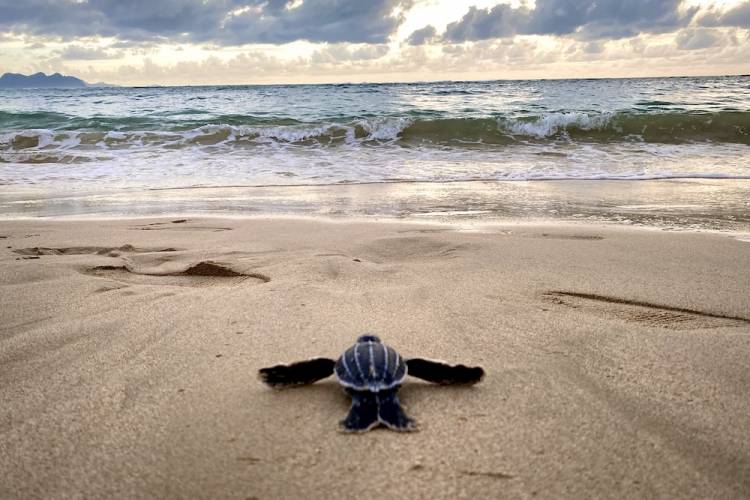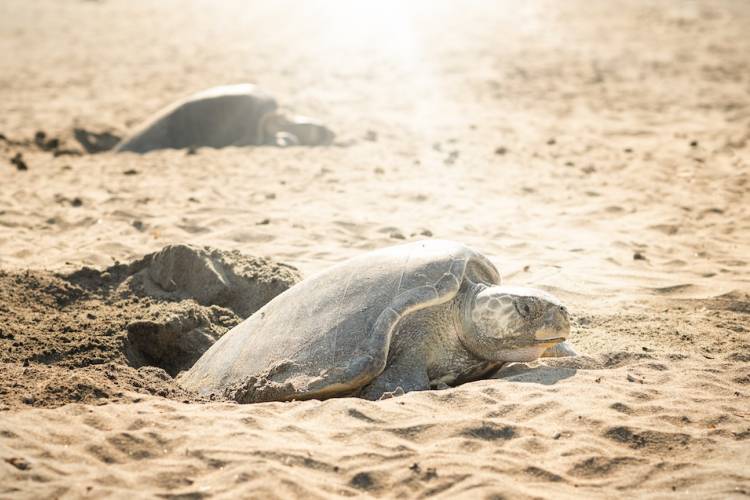Sea Turtles on Hatteras Island
From May through September, the wide, quiet beaches of Hatteras Island become a vital nesting ground for sea turtles. It's one of the most important stretches of shoreline for turtle conservation in North Carolina, with more than 300 nests recorded in a single season. Here, nature still sets the pace, and during turtle nesting season, the beach tells a story that's thousands of years old.
Which Sea Turtles Nest on Hatteras Island?
Three species of sea turtles most commonly use Hatteras Island’s shores to lay their eggs: the loggerhead, the green sea turtle, and the leatherback. Loggerheads are by far the most frequent, but all three species are protected, and in the case of green and leatherback turtles, they are critically endangered. Leatherbacks are true giants, sometimes reaching over 2,000 pounds and living for upwards of 50 years.
Sea turtles come ashore at night to dig nests in the dry sand above the high tide line. Once the eggs are safely buried, the female returns to the ocean, leaving the nest to incubate for about two months before hatchlings break through the surface and begin to make their way to the water.


Nesting Season and Conservation on Hatteras
The National Park Service manages and monitors sea turtle activity on Cape Hatteras National Seashore. Each nest is carefully logged, marked, and sometimes relocated to safer ground if it's too close to the tide or high-traffic areas.
Community education and conservation outreach continue to play a big role in protecting sea turtles. Visitors are encouraged to learn about nesting season guidelines and to share that knowledge with others, helping ensure everyone can enjoy the beach while keeping it safe for our beloved wildlife.
What to Know if You Visit During Nesting Season
If you're planning a beach day on Hatteras Island between May and October, a little extra care goes a long way:
- Avoid driving near marked nests or dune areas
- Fill in holes and level out sandcastles before leaving
- Remove beach equipment overnight so turtles have a clear path
- Use red LED lights if you must be on the beach after dark
- Keep pets leashed and away from marked nests
- Pack out all trash to prevent attracting predators
These small actions help ensure that sea turtles have the best chance at survival.
How Hatteras Island Supports Sea Turtle Conservation
Beyond nest protection, education plays a big role in conservation here. The Hatteras Island Ocean Center offers interactive programs about local marine life, including sea turtles. Their work helps connect vacationers and residents to the wildlife that makes this area so special.
Groups like the Network for Endangered Sea Turtles (N.E.S.T.) operate in the northern OBX but are part of a broader effort that inspires awareness and action throughout the barrier islands. Even some team members at Brindley Beach volunteer with these organizations, reflecting the company’s commitment to protecting sea life up and down the coast.


Choose a Vacation Rental Company That Respects the Island
Brindley Beach Vacations and Sales is proud to support efforts that keep Hatteras Island’s beaches safe for wildlife. We even have team members who volunteer their time helping with conservation efforts, reflecting our deep commitment to protecting the unique ecosystems that make our coast so extraordinary.
When you stay with Brindley Beach, you’re choosing a company that understands the responsibility of sharing this shoreline and takes it seriously.
Book your Hatteras Island stay today and help protect what makes this coast unforgettable for your family and for every turtle yet to hatch.
Frequently Asked Questions About Sea Turtles on Hatteras Island
What types of sea turtles nest on Hatteras Island?
Mostly loggerhead, but also green and leatherback sea turtles.
When is sea turtle nesting season on Hatteras Island?
From May through September each year.
Where can I safely see sea turtles or nests?
Nests are sometimes visible along Cape Hatteras National Seashore, especially in the early morning or evening. Please observe from a distance and never approach an active nest or turtle. You'll also spot protective fencing and markers around nests that have already been identified by conservationists.
Why do sea turtles come to Hatteras Island?
The island's long, undisturbed beaches provide ideal nesting conditions, with soft sand above the high tide line and minimal light pollution.
What should I do if I see a nesting turtle or hatchlings?
Keep a respectful distance, turn off any lights, and contact National Park Service staff. Never interfere or try to "help."
How can I help protect sea turtles on Hatteras Island?
Drive carefully on the beach, leave no trash behind, use turtle-safe lighting, and follow posted guidance near nesting areas.



